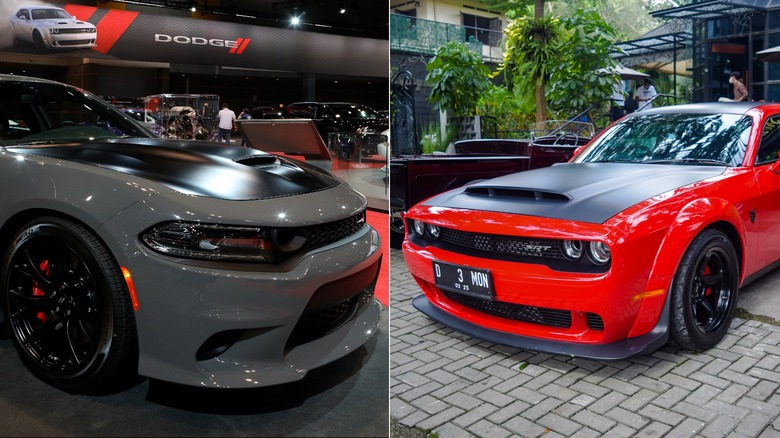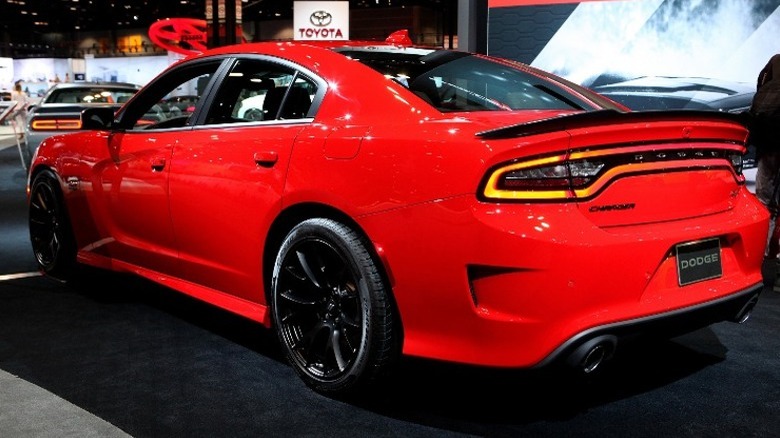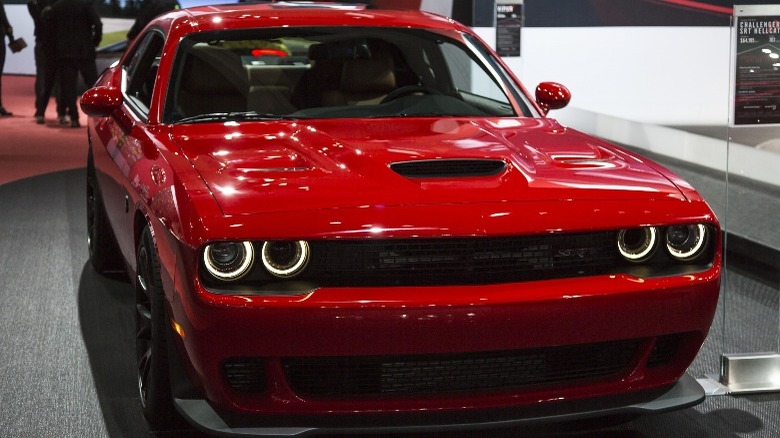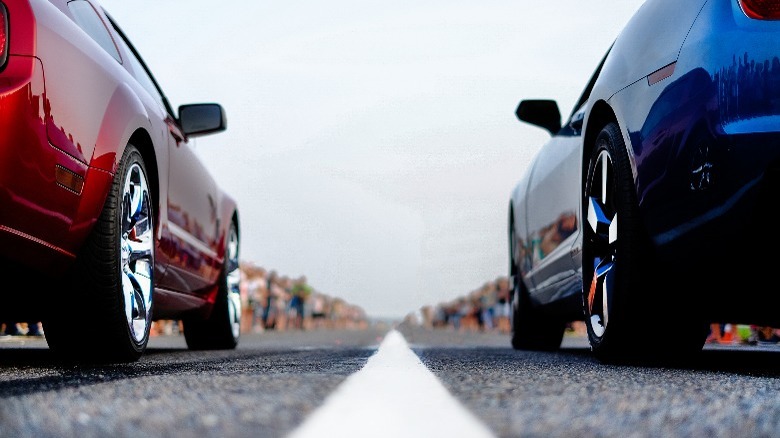Dodge Scat Pack Vs. Hellcat: Which Has More Horsepower?
The Scat Pack Dodges are respectable machines in their own right, but are they any match for the (in)famous Hellcat? Many arguments about which car has a better engine are often settled by drawing the horsepower card. Since that's the purpose of this debate, we'll save you some time and tell you right now that the Hellcat wins by a mile and a half.
Look, there's a reason Hellcats are such powerful rear tire shredders — it's all thanks to their 700+ hp supercharged 6.2-liter Hemi V8 engines tasking those back tires. When you compare that to the naturally aspirated 392ci (6.4-liter) Hemi V8 engine, the 485 hp (which is quite powerful by itself) begins to feel a little paltry.
If you're still here, that means you would like to know why the Hellcat outperforms its Scat Pack brethren. We've delved into the details and built some context around why there's such a power gap between the two and why (for better or worse) it's not such a bad thing.
Isn't the Dodge Scat Pack a group of cars?
If you're an old-timer, when you hear the word "Scat Pack," you'll remember the original Scat Pack that started in 1968. All the Mopar cars in the lineup that could beat the quarter mile in about 14 seconds made it to this exclusive club. The cars in the pack include the Dodge Dart GTS, Dodge Charger R/T, and Challenger R/T, just to name some popular ones. However, with time, the Scat Pack faded into the annals of history — until 2014/2015, when Chrysler brought it back as a trim option for the Challenger and Charger.
You'll find the Scat Pack as a trim level between the relatively modest Challenger R/T and the Hellcat. It was built to be a cheaper, less powerful alternative to the supercharged Hellcat option. Essentially, the Scat Pack boosts the base R/T from 375 horsepower at 5,150 rpm to 485 hp at 6,100 rpm. All of that is thanks to the 6.4-liter 392 HEMI V8 engine. A stark upgrade from the base R/T's 5.7-liter displacement.
A Scat Pack Dodge is built for advanced performance, so it also comes with additional enhancements like 20-inch wheels, better brakes, launch control, and a widebody option. It's typically paired with an 8-speed automatic (Charger) or a 6-speed manual (Challenger) transmission.
So, the Hellcat is a designation for the Charger and Challenger?
"Hellcat" is actually a designation for a type of Dodge Charger and Challenger with a supercharged 6.2-liter V8 engine. The cars stand out not just for their fame and performance, however. Even the uninitiated can spot them through the snarling demon cat logos on the Hellcat. Its modern story starts with the 2015 Dodge Challenger SRT Hellcat that did a whopping 707 hp and 650 lb-ft of torque. These figures helped it earn the number one spot from the Camaro ZL1 (that had 580 hp) as the leading American muscle with the most power straight out of the factory.
As the years have plowed on since the Hellcat's debut, the horsepower numbers have remained more or less the same. It's unsurprising because there's only so much power a muscle car can have. But in 2019, the Hellcat reincarnated with an even more powerful tier: the Hellcat Redeye. These beasts took the Hellcat to a whole new level, giving us Challengers and Chargers that could do 797 hp. They were built based on the Demon's 808-hp engine but fitted with a larger 2.7-liter supercharger, whereas the regular Hellcat uses a 2.4-liter supercharger.
The caveat you probably saw coming ages ago is the cost. Edmunds' used car prices list "entry-level" Hellcat Challengers for about $70,000 — but you could get a Challenger R/T Scat Pack of the same year for about $46,000. An extra $25,000 is a lot of money for all that horsepower you probably will never get to utilize fully.
How do the Scat Pack and Hellcat compare?
How the Dodge options are ranked places the Scat Pack and the Hellcat at the top of the line. They both have been at the pinnacle of many Challenger or Charger options since 2015. Here's a general guideline on how the labels rank based on horsepower, sourced on Edmunds.
- SE, SXT, and GT — 292 to 305 horsepower
- R/T, Daytona, and T/A — 370 to 375 horsepower
- Scat Pack and 392 — 485 horsepower
- Hellcat — 707 to 717 horsepower
- Hellcat Redeye — 797 horsepower
- SRT Super Stock — 797 to 807 horsepower
- Demon — 808 horsepower
Even though the Scat Pack has a bigger 6.4-liter engine, the supercharger makes up for all the difference and places the Hellcat on top of it by over 220 horsepower. Let's also not forget the raw power difference between the two. Hellcats can manage about 650 to 700 lb-ft of torque, whereas Scat Packs have always been limited to 475 lb-ft of torque.
As for the enthusiasts who believe engine numbers aren't all it takes, one look at the acceleration and quarter-mile records should be enough. When Car and Driver pushed the 2023 Hellcat Redeye Challenger down its test track, it finished the quarter mile in 11.8 seconds and reached 60 mph from a standstill in 3.6 seconds. Granted, there are cars with lower horsepower that could beat that time, but the only opponent here is the same car with a Scat Pack. MotorTrend reports that the Scat Pack goes from zero to 60 in 4.3 seconds and beats the quarter-mile in 12.4 seconds.



